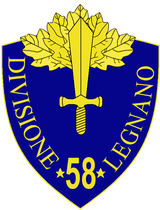|
58th Infantry Division "Legnano"
The 58th Infantry Division "Legnano" (Italian: 58ª Divisione di fanteria "Legnano") was an infantry division of the Royal Italian Army during World War II. The Legnano's predecessor division was formed on 8 February 1934 in Milan and named for the medieval Battle of Legnano. On 24 May 1939 the division split to form the 6th Infantry Division "Cuneo" and the 58th Infantry Division "Legnano". After the announcement of the Armistice of Cassibile the Legnano resisted the invading German forces. The division's staff and 67th Infantry Regiment "Legnano" were used to form the first unit of the Italian Co-belligerent Army, which fought on the allied side in the Italian campaign. On 17 February 1944 the division's last units joined other commands and the division was officially dissolved.[1][2] HistoryThe division's lineage begins with the Brigade "Palermo" established in Turin on 1 August 1862 with the 67th and 68th infantry regiments.[3] World War IThe brigade fought on the Italian front in World War I. On 1 November 1926 the brigade command was disbanded and the brigade's two regiments were transferred to other brigades: the 67th Infantry Regiment "Palermo" to the VI Infantry Brigade and the 68th Infantry Regiment "Palermo" to the II Infantry Brigade.[4][5] The VI Infantry Brigade also included the 7th Infantry Regiment "Cuneo" and 8th Infantry Regiment "Cuneo". The brigade was the infantry component of the 6th Territorial Division of Milano, which also included the 27th Field Artillery Regiment. In 1934 the division changed its name to 6th Infantry Division "Legnano". On 24 May 1939 the 6th Infantry Division "Legnano" was renamed 6th Infantry Division "Cuneo" and transferred the "Legnano" name together with the 67th Infantry Regiment "Palermo" to the newly activated 58th Infantry Division "Legnano". On the same date the Legnano division received the 68th Infantry Regiment "Palermo" from the 2nd Infantry Division "Sforzesca" and the newly raised 58th Artillery Regiment. All three regiments of the Legnano division were then renamed "Legano".[6][1] World War IIInvasion of FranceIn June 1940 during the Italian invasion of France the division remained in the Fenestrelle-Col de Fenestre area as reserve of the 4th Army. On 21-24 June 1940 the division entered the front in the Colle del Monginevro area. After the Franco-Italian Armistice was signed on 24 June 1940 the Legnano moved to Briançon for occupation duty.[2] Greco-Italian WarIn early January 1941 the Legnano was transferred to Albania to reinforce the Italian front in the Greco-Italian War. On 7 January 1941 the Legnano entered the front in the sector along the coast. On 25 January the division was sent to the Golikut sector, where the next day the division participated in the Italian attack with the aim to recapture Këlcyrë pass in the Battle of Trebeshina. On 8 March 1941 the division went on the defensive and did not participate in the initial stage of the Italian Spring Offensive. After Greek units withdrew from the Albanian front during the Battle of Greece, the Legnano advanced and reached Këlcyrë on 16 April 1941. The division then advanced to Kuman before being reassigned as reserve of the 9th Army. On 21 June the Legnano began boarding ships in Vlorë for the return to Lombardy. The division was then sent to Liguria for coastal defense duties.[1] Occupation of Vichy FranceIn November 1942 the division participated in the Occupation of Vichy France and was then deployed for coastal defence duty in the Cannes-Saint-Tropez sector of the Italian occupation zone.[1] Operation AchseIn August 1943 the division was ordered to move to Apulia in the south east of Italy. The division's units were moved by rail through Bologna and then to Brindisi. After the Armistice of Cassibile was announced on 8 September 1943, some units were already at Brindisi and Francavilla Fontana, while others were stranded in Bologna or in locations on the way to their destination. Together with the 152nd Infantry Division "Piceno", the 210th Coastal Division, and the XXXI Coastal Brigade the units of the Legnano in Apulia deployed to form a defensive line from Taranto through Grottaglie, Francavilla Fontana, and Latiano to Brindisi, to screen the landing of the British 1st Airborne Division at Taranto on 9 September from attacks of the German 1st Fallschirmjäger Division.[7] Italian Co-belligerent ArmyOn 26 September 1943 the division's command was used to raise the I Motorized Grouping, which was to aid the Allied war effort. In the following months, the division's units were transferred to other commands fighting in the Italian campaign. On 17 February 1944 the division's last units joined other commands and the division was officially dissolved. On 24 September 1944 the II Brigade of the Italian Liberation Corps was renamed as Combat Group "Legnano". The Combat Group consisted of the 68th Infantry Regiment "Legnano", the 11th Motorized Artillery Regiment, the IX Assault Battalion and the Special Infantry Regiment, which contained the remnants of the 3rd Alpini Regiment and 4th Bersaglieri Regiment. The Combat Group was equipped with British weapons and materiel. The new Legnano went to the front as part of the II Polish Corps, on the extreme left of the British 8th Army near the river Idice, and was tasked with liberating Bologna. Organization58th Infantry Division "Legnano"
Attached to the division from June to December 1940:[2]
Attached to the division from December 1940 until early 1942:[2]
Attached to the division in France in August 1943:[2]
Attached to the division in Southern Italy on 8 September 1943:[2]
1st Motorized Grouping
Military honorsFor its conduct during the Allied campaign to liberate Italy the President of Italy awarded on 12 December 1948 to the 67th Infantry Regiment "Legnano" Italy's highest military honor, the Gold Medal of Military Valor.
Commanding officersThe division's commanding officers were:[1][2]
Notes
References
Bibliography
|
||||||||||||||||||||||
Portal di Ensiklopedia Dunia
